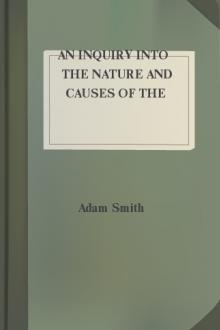The Wealth of Nations by Adam Smith (the best motivational books .TXT) 📕

- Author: Adam Smith
Book online «The Wealth of Nations by Adam Smith (the best motivational books .TXT) 📕». Author Adam Smith
The confession of faith of the Économistes is embodied in Quesnay’s Tableau Économique, which one of them described as worthy of being ranked, along with writing and money, as one of the three greatest inventions of the human race.65 It is reprinted on the next page from the facsimile of the edition of 1759, published by the British Economic Association (now the Royal Economic Society) in 1894.
Those who are curious as to the exact meaning of the zigzag lines may study Quesnay’s Explication, which the British Economic Association published along with the table in 1894. For our present purposes it is sufficient to see (1) that it involves a conception of the whole annual produce or reproduction of a country; (2) that it teaches that some labour is unproductive, that to maintain the annual produce certain “avances” are necessary, and that this annual produce is “distributed.” Adam Smith, as his chapter on agricultural systems shows, did not appreciate the minutiæ of the table very highly, but he certainly took these main ideas and adapted them as well as he could to his Glasgow theories. With those theories the conception of an annual produce was in no way inconsistent, and he had no difficulty in adopting annual produce as the wealth of a nation, though he very often forgetfully falls back into older ways of speaking. As to unproductive labour, he was not prepared to condemn the whole of Glasgow industry as sterile, but was ready to place the medieval retainer and even the modern menial servant in the unproductive class. He would even go a little farther and put along with them all whose labour did not produce particular vendible objects, or who were not employed for the money-gain of their employers. Becoming somewhat confused among these distinctions and the physiocratic doctrine of “avances,” he imagined a close connection between the employment of productive labour and the accumulation and employment of capital. Hence with the aid of the common observation that where a capitalist appears, labourers soon spring up, he arrived at the view that the amount of capital in a country determines the number of “useful and productive” labourers. Finally he slipped into his theory of prices and their component parts the suggestion that as the price of any one commodity is divided between wages, profits and rent, so the whole produce is divided between labourers, capitalists, and landlords.
These ideas about capital and unproductive labour are certainly of great importance in the history of economic theory, but they were fundamentally unsound, and were never so universally accepted as is commonly supposed. The conception of the wealth of nations as an annual produce, annually distributed, however, has been of immense value. Like other conceptions of the kind it was certain to come. It might have been evolved direct from Davenant or Petty nearly a century before. We need not suppose that someone else would not soon have given it its place in English economics if Adam Smith had not done so, but that need not deter us from recording the fact that it was he who introduced it, and that he introduced it in consequence of his association with the Économistes.
If we attempt to carry the history of the origin of the Wealth of Nations farther back than the date of the lecture notes in 1763 or thereabouts, we can still find a small amount of authentic information. We know that Smith must have been using practically the same divisions in his lectures in 1759, since he promises in the last paragraph of the Moral Sentiments published in that year, “another discourse” in which he would “endeavour to give an account of the general principles of law and government, and of the different revolutions they have undergone in the different ages and periods of society, not only in what concerns justice, but in what concerns police, revenue and arms, and whatever else is the object of law.” It seems probable, however, that the economic portion of the lectures was not always headed “police, revenue, and arms,” since Millar, who attended the lectures when they were first delivered in 1751–2, says:—
“In the last part of his lectures he examined those political regulations which are founded not upon the principle of justice, but that of expediency, and which are calculated to increase the riches, the power and the prosperity of a state. Under this view, he considered the political institutions relating to commerce, to finances, to ecclesiastical and military establishments. What he delivered on these subjects contained the substance of the work he afterwards published under the title of ‘An Inquiry into the Nature and Causes of the Wealth of Nations.’ ”66
Of course this is not necessarily inconsistent with the economic lectures having been denominated police, revenue, and arms, even at that early date, but the italicising of “justice” and “expediency,” if due to Millar, rather suggests the contrary, and there is no denying that the arrangement of “cheapness or plenty” under “police” may very well have been an afterthought fallen upon to justify the introduction of a mass of economic material into lectures on Jurisprudence. As to the reason why that introduction took place the circumstances of Smith’s first active session at Glasgow suggest another motive besides his love for the subject, which, we may notice, did not prevent him from publishing his views on Ethics first.
His first appointment at Glasgow, it must be remembered, was to the Professorship of Logic in January, 1751, but his engagements at Edinburgh prevented his performing the duties that session. Before the beginning of next session he was asked to act as deputy for Craigie, the Professor of Moral Philosophy, who was going away





Comments (0)